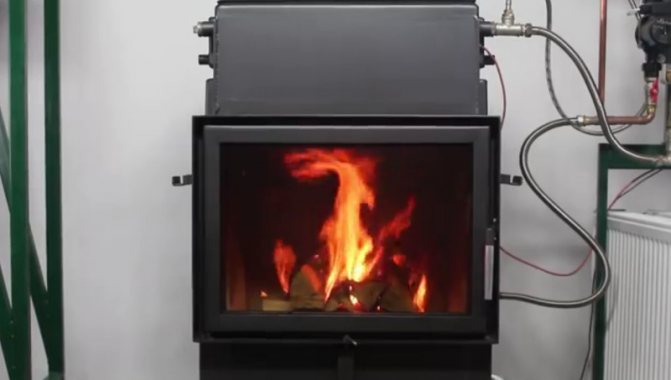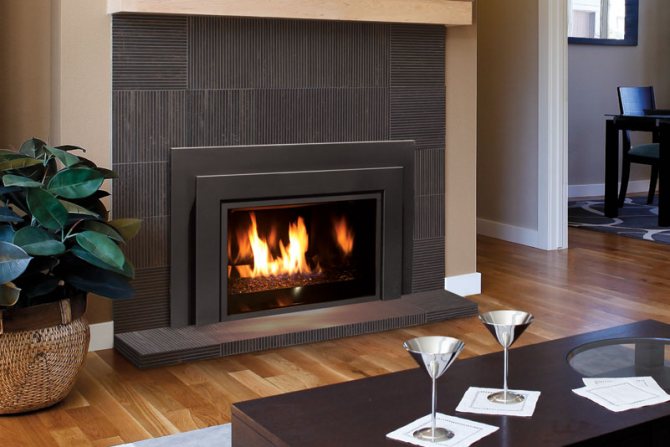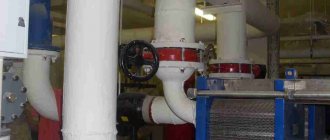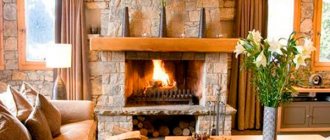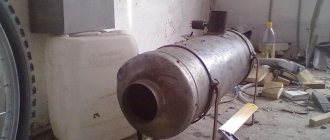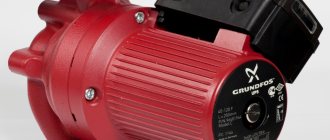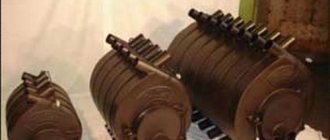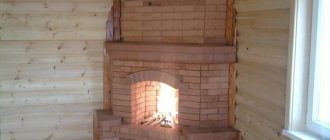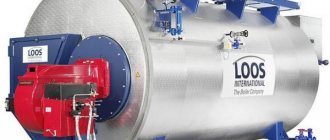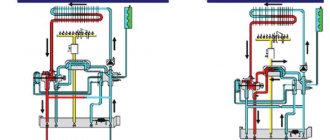07.07.2017 2156 Pechnik (Moscow)
The cassette fireplace has a visual and functional similarity to classic wood-burning stoves. Such structures have a fairly high efficiency and are represented by a combustion chamber, the walls and frame of which are made of high-quality steel or cast iron. The door of closed hearths can be equipped with both a cast forged door and shutters made of heat-resistant transparent glass.
Cassette fireplaces can be fully automated and work without constant and regular monitoring. As additional protection, support and decoration, the hearth can be framed by a portal finished with tiles, terracotta, ceramic tiles, natural or artificial stone.
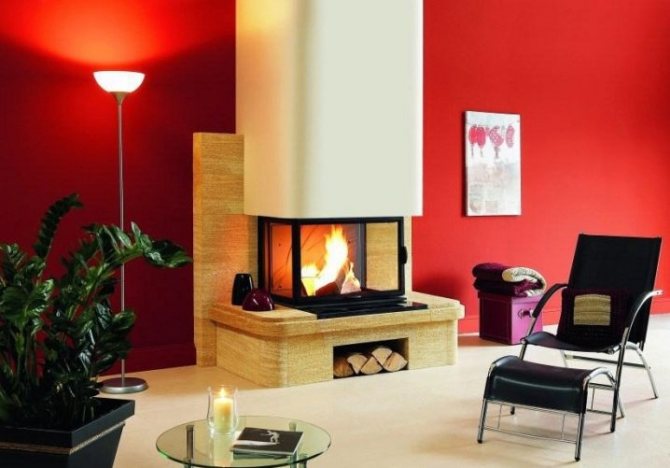
Features of closed cassette foci
Cassette fireplaces, the installation of which does not require significant time expenditure and serious physical effort, has the following distinctive features:
Descriptions and explanations


Installing a cassette fireplace with a closed hearth is the most effective and powerful. Such devices have high efficiency and can act as both the main and additional source of heating at home.
Open models do not differ in high efficiency and sufficient heat capacity. In this case, all the heating goes not into the walls of the structure, but into the air, and thus does not allow high-quality heating. These fireplaces play a decorative role.


The device of cassette fireplaces includes a chimney. This element has a small cross-section and a shortened size. This makes the use and placement of such a heating unit as convenient as possible.
Due to the shortened chimney, the products of combustion and decay are quickly removed to the street and do not linger in the inner part of the hearth.


The fireplace cassette is the main distinguishing feature of this design. This element is responsible for the uniformity and speed of heating and allows you to perform the fastest possible heating of the premises.
For even distribution of air masses, special fans can be used that distribute hot air masses.
Some models with fireplace cassettes are equipped with built-in air ducts that supply air at random. If necessary, such air ducts can be closed at the top with valves.


The price for such models is affordable compared to electric and wood-burning installations. The cost is due to the simple principle of operation and the minimum set of functions.
The most budgetary option will be a cassette fireplace, which is represented by a steel body and a simple door equipped with a horizontal mechanism.
Important: by installing
do-it-yourself cassette fireplace, it is necessary to coordinate the installation and conduct of the chimney with special services and organizations. The location of this element in the space of the selected room should be as convenient and correct as possible. Only refractory materials are used as heat-insulating materials and connecting vertical and horizontal elements, and all seams and joints are well sealed.
In order to familiarize yourself with such heating installations in more detail and find out what constitutes a cassette-type fireplace, we also recommend viewing the photos collected in this article.
Formation of value and choice of interior solutions
A cassette-type fireplace can also have doors with a vertical folding mechanism.Such ovens have a higher cost due to their unique design, different shapes and finishes.
The best choice would be a heating unit with shutters equipped with fireproof glass. It can be completely smooth and transparent, as well as matte, refrain and colored, as well as mosaic. Many manufacturers equip their products with useful and important features. For example, due to the constant air circulation inside the structure, the glass can be cleaned on its own and is less prone to various contaminants.


For fire safety purposes, all structural elements


For storing firewood and briquettes, a small firebox is often used, provided by the portal design.


Floor surface within
Interesting to know:
fireplace cassetteis responsible for the circulation of air masses around its axis. Thus, the cold air present in the room enters the inside of the oven and heats up, after which it goes back into the room.
Important: in order to
fireplace cassettescould intensively and evenly distribute the heated air over several rooms at once, during installation, it is recommended to install a special metal disk, which, when rotating, will additionally distribute air masses over the ventilation grilles.
Varieties of cassette models
The fireplace cassette can be of a certain variety. The choice of a suitable model is made based on such parameters as power, size and heating footage:
- Cassettes for fireplace stoves can be installed in an open hearth. Such models are characterized by low efficiency and are intended for heating rooms with a small area;
- Heat cassettes for fireplaces are often installed in a closed-type combustion chamber. Such stoves are more efficient, and the cassettes themselves have a higher power and are intended for heating houses with a sufficiently large footage.


The most expensive are multifunctional models.


Corner cassette hearths take up little space.
Interesting to know: the most expensive
heat cassettes for fireplaceequipped with fireclay lining. Finishing with such materials significantly increases power and heat transfer. If necessary, both these and more budget cassettes can be easily replaced with similar ones.
We make a decision
Before making your choice and deciding in favor of such fireplaces, you will need to study not only the device of the cassette fireplace, but also its distinctive features, which include not only advantages, but also disadvantages:
- Manufacturers offer ready-made lines, the models presented in which differ not only in their size and method of placement, but also in style (from baroque to minimalism);
- Such ovens cool down quickly enough and are not able to continue heating when inoperative. In order for the heat to remain as long as possible after the end of the firebox, it is recommended to make a portal from a material such as brick;
- Some types of cassettes can be connected to special pumps and tanks that heat water and distribute it through the general heating system of the house. Such fireplaces are also classified as having a water circuit;
- Also, the adjustable mechanism can be not only water, but also air. In this case, heating the structure must be done after a short period of time, for example, every 4-6 hours;
- Due to the need for a chimney, such heating units can be placed exclusively in private houses or on the last floors of multi-apartment high-rise buildings;
- The flue duct in such models is always equipped with a glass damper.Due to this, the efficiency and speed of heating with such methods is significantly increased.
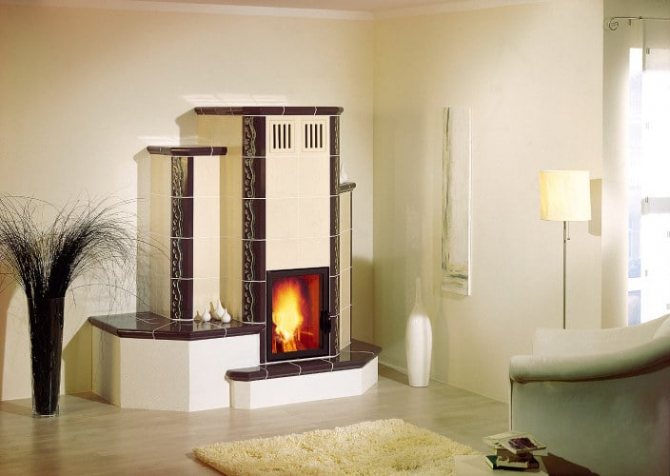

For finishing the frames, you can use
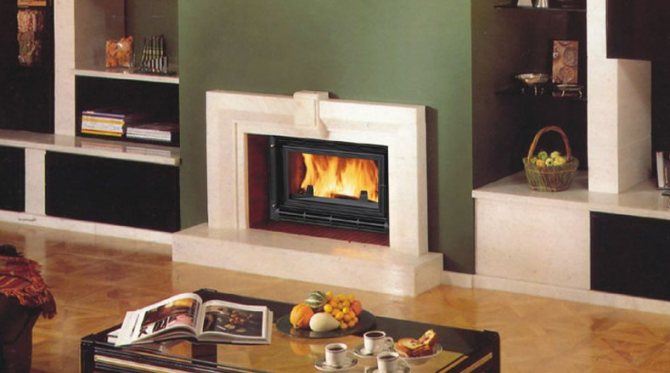

The closed combustion chamber has a higher heat capacity.


Model complete with support legs without portal


Built-in cassette hearth
Important: the installation of such foci is impossible without a chimney. Accommodation and other requirements are specified in more detail in the PB.
The video in this article will help you learn in more detail about the advantages and disadvantages of such combustion chambers.
We carry out installation
At the first stage, it is necessary to take care of the chimney. Installation of the hearth is carried out on almost any floor, and additional reinforcement is not required. If the mass of the fireplace plays an important role, you can find out from the attached documentation.
Assembly and installation instructions:
- The casing and the main part of the fireplace should have a small gap. To separate the outer box from the pipe itself, the surface must be insulated with refractory materials (mineral or basalt wool is used);
- The diameter of such a chimney has a smaller pipe cross-section than in standard classical furnace units. The number of rotary, horizontal elements and layouts in this case can also be increased;
- To install the hearth at the first stage, you will need to make the floor covering even. This is necessary to give the structure stability. If the floor is made of wood, it should be partially reinforced with concrete;
- The floor and wall surfaces located near the combustion chamber must also have an appropriate finish with heat-resistant materials. As additional protection, it is recommended to cover the floor and walls with a special varnish or refractory impregnation;
- With the initial presence of a chimney with a suitable cross-sectional diameter, it can be used to connect it. Before use, a complete cleaning of the inside is carried out and the tightness of both the entire structure as a whole and each individual joint and section is checked;
- Fixation of each element is carried out by means of cuffs and couplings;
- For fire safety purposes, heating elements should not come into close contact with walls, portal and other elements;
- The walls are additionally insulated, and the framing is made of plasterboard or any other heat-resistant materials.
The advantages of fireplace stoves
Fireplace stoves combine the positive qualities of these heating devices, while they are devoid of their inherent disadvantages. What are the main differences between a traditional stove and a fireplace?
- The oven takes a long time to heat up, but is capable of accumulating heat and for a long time to emit radiant energy from the walls of the furnace into the surrounding space. The heat from the fireplace immediately spreads throughout the room, in which it is installed, but after stopping the firebox, it cools down quickly and the temperature in the house decreases.
- Firebox heating ovens usually performed with blind door small size, this reduces the likelihood of smoke and improves traction. Fireplace insert - open, occupies about half of the area of its facade. With an improperly folded chimney or bad weather conditions, reverse draft and smoke can enter the room, which leads to an unpleasant odor, deposition of soot and soot on household items.
- The smoke exhaust system of the stove has a complex design: the smoke in them passes through numerous channels, giving off most of the heat to the body of the stove. It comes out of the pipe practically cooled down. Chimneyalmost straight in the fireplace, the smoke is retained only under the arch, so its outlet temperature is much higher, and heat removal is worse.
- Efficiency heating ovens on average is 60-80%, near fireplaces - no more than 50%.
- The stove is not too decorative, and you can give it an aesthetic look only with the help of finishing. Fireplace even by itself - interior decoration, and flames decorate it even more.
In the models of industrial production, all the features of these heating devices are taken into account, the most significant disadvantages are eliminated and the advantages are emphasized. As a result, modern fireplace stoves have a number of advantages:
- high efficiency - up to 80%, and when connecting a heating water circuit - up to 92%;
- a sealed firebox with large glass that allows you to observe the flame, but does not allow smoke to enter the room;
- smoke ducts with a smoke circulation and a heat exchanger, which improves heat removal and its transfer to the room;
- aesthetic appearance, there are models decorated with ceramic panels or metal forging;
- light weight - they can be installed even on wooden floors laid on logs, without erecting a foundation;
- small dimensions with high power - fireplace stoves do not take up space, which is very important for small houses;
- the ability to connect a water circuit allows you to heat all the rooms of the house and keep warm for a long time, as well as avoid daily temperature fluctuations;
- low price compared to the cost of materials and work for the construction of brick stoves or fireplaces;
- easy and quick installation that you can do yourself.
In addition, modern fireplace stoves can have a number of other useful features:
- hob;
- a glass cleaning system that prevents it from darkening, as well as a long-term burning mode, which is very popular among consumers.
The reviews of the owners of such stoves are unambiguous: stoves can heat a residential building for a long time and effectively, without causing problems and hassle to the owners.
Installation


Installation can be done independently, that is, with your own hands. When working, you should strictly follow all the rules and instructions of fire supervision, use non-combustible materials with properties that prevent ignition and support combustion.
There are three main installation methods:
- integration into an existing heating stove;
- device of a new product, when the inventory glass door remains outside, and the method of connecting the chimney and the surrounding decorative cladding is left to the discretion of the owner (designer, architect, designer);
- installation as an independent free-standing unit with its own decorative finish and cladding.
If the product is built into an old heating stove, its firebox expands to the dimensions of the seat recommended by the manufacturer. The existing chimney is disassembled so that in its place a new smoke extraction device can be installed in the fireproof casing. Further, a fire safety audit and a refractory lining are carried out.
Don't Miss: Fireplace made of wood with your own hands: the choice of material and finishes
When installing a new built-in or freestanding product, the wall (or two adjacent walls for corner placement) and floor must be cleaned of existing finishes. It is good if the walls are made of bricks and the floor is made of concrete. Otherwise, a screed made of ordinary or expanded clay concrete with a thickness of at least 5 cm is arranged on the floor, which goes beyond the dimensions of the furnace from the side of the firebox by 40 ... 50 centimeters. It is better to additionally lay a steel sheet, 1.5… 3 mm thick, on top of the screed. The walls are sheathed with non-combustible mineral wool, and then protected with refractory cladding - metal sheets, lining bricks, etc.
Chimneys of these structures, unlike conventional furnaces, do not participate in the heat exchange process. They are made from tin or metal as well as asbestos-cement pipes. Fume extractors can be straight or angled if one of the walls is outside. The pipes are protected by metal thin-walled casings, which can be either round (pipe in pipe) or rectangular.
The space between the chimney and the casing is filled with some kind of refractory material, such as expanded clay, expanded perlite sand, mineral wool, etc. The straight casing can be masked by a cladding that resembles the walls of the chimney of a conventional stove or fireplace. When exposed to the wall from the outside, the vertical part of the casing can be overlaid with bricks and made in the form of a pilaster or a half-column. Passages through ceilings and roofs must be safe, excluding fire.
Advice! The chimney must rise above the highest point of the roof to a height of at least 60 cm and end with a spark arrestor and crosswind protection.
At the end of the work, together with the fire inspector, draw up and sign a fire safety act.
Review of popular models
There are many models of stoves and fireplaces from different manufacturers on the market, and it is easy for a buyer who wants to buy them to get confused in the characteristics and descriptions of these devices. Below is an overview of the most popular, according to the reviews of the Russian consumer, models.
AQUA fireplace stoves
The line of fireplace stoves with a water circuit from the META company is represented by the Angara, Pechora, Varta models, which differ in thermal power, shape and appearance, as well as the installation method.
Hangara AQUA with a water circuit has the following characteristics:
- heating power radiated by the stove during the firebox - 13-16 kW;
- heating power of the connected heating system - 5-7 kW;
- steel heat exchanger;
- wall execution;
- the side walls are lined with ceramics;
- panoramic heat-resistant glass;
- outlet diameter of the flue pipe - 150 mm.
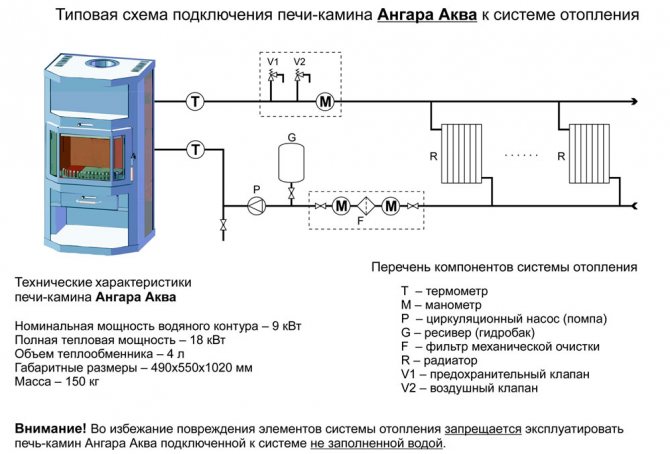

Pechora AQUA differs from Ankara in the shape of the body - it is made compressed prism... Furnace power 13 kW, heating system - up to 5 kW.
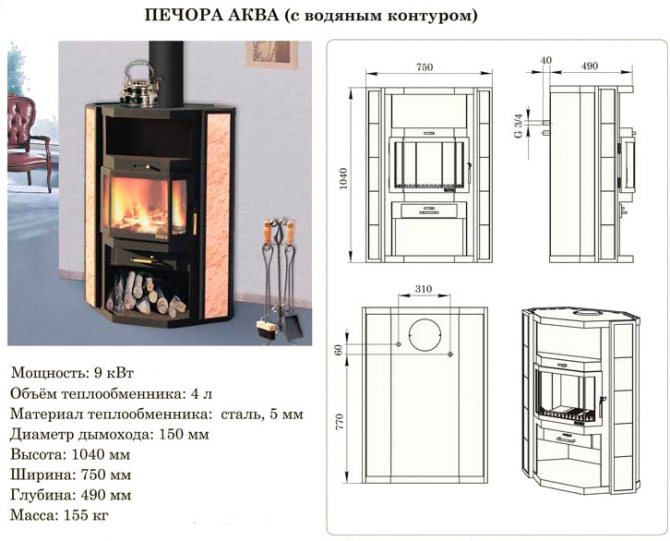

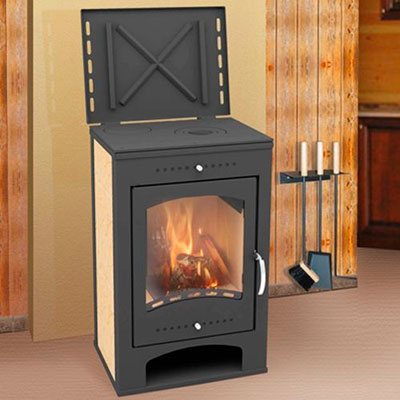

Warta AQUA additionally equipped with a hob, a closing lid. Power 13/5 kW, firebox lined with fireclay. The door is straight, equipped with glass and heat-insulated handles that are resistant to heat.
A feature of the AQUA fireplace stoves with a water circuit from the META company is the ability to connect only to systems with forced circulation.
Fireplace stoves Bavaria
The Bavaria stoves, which have received recognition from the Russian consumer, are produced in both wall and corner versions, and can also be equipped with a stove for cooking and heating food.
Eco fireplace Bavaria, wall-mounted with a heat output of 12 kW, it is equipped with a 6 kW heat exchanger, which can be connected to a system with any type of circulation. The connection diagram is shown in the figure.
Some design features of this type of furnace
A typical wood-burning stove with a water circuit consists of the following main parts:
- Directly oven;
- A cast-iron or steel heat exchanger with a developed contact surface introduced into the furnace space;
- Heating radiators;
- Heat carrier mains, consisting of metal or plastic pipes, valves, a set of valves and splitters;
- Control and safety group equipped with temperature and pressure control devices, as well as emergency valves;
- Expansion tank, which compensates for the excess volume of water that appears due to its heating and subsequent expansion.
- As an additional option, a circulation pump should be considered, which is an indispensable part of a system that works on the principle of forced circulation.


A metal or brick oven with a water circuit can be made according to the principle of natural or forced circulation. A combined system based on the practical application of both principles should be considered as a compromise option.
Natural circulation system
Natural or thermosyphon circulation is ensured on the basis of the principle of natural expansion of water when heated and its movement in the required direction, given by means of slopes. A prerequisite for the reliable functioning of such a system should be considered a number of fundamental principles:
- The oven heat exchanger must be below the level of the radiators.
- The cross-section of pipes of the main fittings must be at least 57 mm, with a nominal heating value of the furnace at the level of 15 - 17 kW.
- The system should be equipped with an expansion tank at a height that ensures reliable circulation of the outgoing flow. As a rule, at least 215 cm from the level of the bottom edge of the heat exchanger.
- The return flow line must be installed with strict observance of the slope level, which guarantees free circulation of the cooled heat carrier on the way to the furnace heat exchanger.
The natural circulation system is absolutely non-volatile, however, it requires more coolant in the system. First of all, due to the large flow area of the line.
Important! Most of the heating specialists are convinced that the natural circulation system loses in thermal efficiency to its direct competitor based on the principles of forced circulation.
Forced circulation system
Its functioning does not require a sufficiently large cross-section of the line, since the coolant is "pressed through" under pressure, through the operation of a vortex-type circulation pump. Obviously, modern production also operates with pumps of other types. A decrease in the volume of the coolant due to a significant underestimation of the cross-section of the mains leads to a significantly higher thermal efficiency of the system as a whole and fuel economy, in particular.
In addition, heating radiators equipped with Mayevsky taps allow quickly and efficiently eliminating air "plugs" by creating excess pressure. The fact of active circulation also determines the presence of an expansion tank of a significantly smaller volume, compared to thermosyphon systems. The most significant drawback of such furnaces is the fact of direct dependence on uninterrupted power supply. The emergence of combined systems should be considered an attempt to combat this drawback.
Combined coolant circulation system
It is a thermosyphon-type system equipped with a circulation pump. An additional option is a bypass hinge equipped with a rotary valve. Under normal conditions, the pump operates, in the absence of power supply, the inlet pipe with the pump is closed, and circulation is provided through a bypass loop made of a large-section pipe.
In fact, this is the same thermosyphon system, with all its inherent disadvantages, however, retrofitted with a pump. In this form, only a two-circuit oven for a bath is rationally seen, where the second circuit is used for hot water supply. Then a large volume of heating medium can be used to meet the demand for hot water.
Features of the selection, installation and operation of fireplaces
In order for home heating to be effective and safe, when buying, installing and using industrial stoves with a fireplace effect, you need to take into account some of the nuances:
- selection of power;
- body and heat exchanger material;
- conditions for safe installation;
- rules for connecting to the heating system;
- requirements for the arrangement of the chimney;
- selection of firewood and other types of fuel;
- proper firebox, cleaning and do-it-yourself maintenance.
You should also follow the manufacturer's recommendations specified in the documentation for the oven. Only in this case will the operation of the furnace be safe and the service life will be long.
Choice of oven power
The most important parameter, which must be considered before buying a particular model - heat output of the heating unit... It is measured in kilowatts, and it is generally accepted that 1 kW of stove power can heat 10 m² of house area.
However, it should be borne in mind that the manufacturer tests the stove in conditions close to ideal, and when using insufficiently dried wood, its power may decrease by a third. Therefore, to use a stove with a heating circuit as the only source of heating, it is better to buy a model with a small power reserve.
Steel or cast iron?
Heating stoves-fireplaces are steel and cast iron. Steel furnaces are cheaper, lighter, but more susceptible to corrosion. Models made entirely of cast iron have increased durability, corrosion resistance, but at the same time they are much heavier, they are afraid of sudden changes in temperature, from which they can crack.
The best option is combined models, in which the body and slightly heated elements are made of steel, and the elements of the furnace, grates and doors that are exposed to strong overheating are made of forged cast iron. They are not afraid of prolonged exposure to high temperatures and are suitable for constant use, and with intermittent heating, the condensate formed in the pipes does not cause corrosion.
Installing a fireplace stove
Due to their low weight, industrial models do not have special requirements for floor preparation, they do not need a separate foundation. The only requirement is the finishing of wooden floors with non-combustible materials.: sheet metal, ceramic tiles or fire-resistant types of coating, which can be done by hand at a minimum cost.
Video: installing a fireplace stove Bavaria
Heating connection
Most industrial fireplace stoves can be operated with or without a connected water circuit. Moreover, their service life does not differ significantly.
If the fireplace stove is connected to a water circuit, under no circumstances should it be operated with the heating medium drained! This will lead to damage to the heat exchanger and the system itself! Furnaces with a water circuit can be used in systems with both natural circulation (gravitational) and forced (using a pump). At the same time, the connection diagrams to the heating system do not differ from traditional ones.
Features of connecting a furnace with your own hands to a gravitational heating system:
- Immediately after leaving the heat exchanger, a booster manifold is performed, which raises the coolant to the upper point of the system.
- An open or membrane-type expansion tank is installed at the top point.
- For the main pipe, a minimum diameter of 32 mm is required; with a smaller pipe section, the hydraulic resistance of the system increases, which leads to a deterioration in circulation.
- The slope of the main pipe should be at least 5 cm / 1 m, otherwise the movement of the coolant will slow down, the temperature in the system will be uneven, and heating will be ineffective.
- The pipe bends to the radiators should have a diameter of 16-20 mm. Radiators cut parallel to the line in a lower or diagonal pattern.
When using a forced system, the requirements for its installation are much less:
- The expansion tank can be installed in any convenient place, usually it is placed on the return pipe, after the circulation pump.
- The radiator connection diagram can be any.
- It is not necessary to withstand a significant slope of the main pipe.
- With the help of automation, you can set the speed of movement of the coolant, as well as the return temperature, which will avoid the appearance of condensate in the firebox.


The choice of a heat carrier is an equally important step, which depends on the operating mode of the furnace.... For houses with permanent residence, it is more convenient to use purified water - it is cheaper, practically does not cause corrosion in a closed heating system, it can be easily topped up from the water supply if necessary.
If the house is used intermittently, using water during the winter may freeze the system.At the same time, the water expands and damages the elements of the system: pipes, radiators, fittings, which will subsequently lead to leaks.
In this case, you can use special antifreezes, or install an electric boiler parallel to the oven, operating in the mode of automatically maintaining a plus temperature at the level of 5-10 ° C.
Chimney requirements
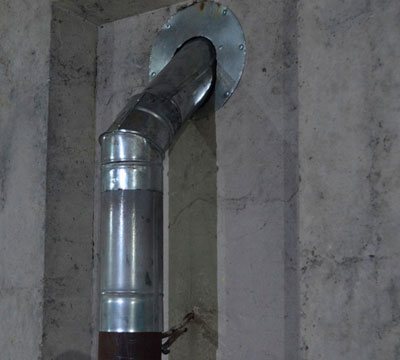

For safe operation, fireplace stoves require strict adherence to the rules for installing a chimney... For these heating devices, experienced stove-makers advise to install chimneys made of ceramics or stainless steel of the "sandwich" type.
Ceramic chimneys are a prefabricated structure of ready-made blocks for various purposes. The flue gas duct consists of glazed ceramics, which eliminates the swirling of smoke and the deposition of solid sediment. It is placed in a hollow foam concrete block and insulated with basalt mats, heat-resistant at temperatures up to 1000 ° C. The elements are connected to special glue (blocks) and sealant (ceramics).


Metal sandwich chimneys look like two pipes of different diameters, inserted into one another and insulated with basalt. The inner tube is made of stainless steel, the outer one can be made of galvanized iron. The blocks are assembled with a heat resistant sealant.
Features of ceramic chimneys:
- long service life - at least 25 years;
- the smooth inner surface practically does not allow soot to settle;
- high fire safety and resistance to burnout;
- heavy weight, which requires installation on a separate foundation;
- high price.
Features of stainless steel chimneys:
- quickly assembles with his own hands;
- the price is much lower than ceramic;
- does not require installation on a foundation;
- with constant overheating, they can burn out, therefore regular revision is necessary.
Video: comparison of different chimneys
The choice of the type of chimney is a matter of preferences and financial capabilities, however, when installing it, several prerequisites must be observed.
- The diameter of the chimney should ideally be equal to the diameter of the flue outlet, or pipe. You can't narrow it down! It is possible to expand the diameter of the chimney, but not more than 30%, while it is necessary to use special elements of the chimney.
- The chimney must be equipped with a gate or valve that blocks the flow of cold air into the furnace and regulates the draft.
- The total length of the horizontal sections should not exceed 1 meter, otherwise the thrust will be much worse.
- The total height of the chimney and chimney must not be less than that indicated in the passport for the stove. Usually this value ranges from 5 to 8 meters.
- All passages through walls and ceilings are made with the help of special elements that ensure their thermal insulation from combustible structures.
- It is necessary to equip the chimney with cleaners that provide access to any part of it, as well as a condensate collector.
Heating system device
In order to qualitatively consider the principle of energy conversion, the entire heating system should be divided into two conditional blocks: the heat exchanger and the line itself.
The heat exchanger for the fireplace can be made in the form of a pipe through which water flows. To increase the efficiency of heat transfer, it is necessary to increase the area of the heat exchanger located in the core (furnace zone), therefore, the pipe is made in the form of a coil, radiator or other version of the labyrinth. This unit, even in brick fireplaces, is made of cast iron or steel. The cast iron coil is capable of perfectly transferring heat to the circulating fluid and withstands exposure to temperatures. But casting from cast iron significantly increases the cost of making a fireplace, so a steel structure is an alternative.
The constant temperature drop and the effect of an open flame on a steel heat exchanger leads to a rapid failure of the latter.Considering all the nuances, two different schemes for transferring heat from flame to water are used.
- The first circuit is called single-circuit. The cast iron coil is located in the firebox and is heated by direct contact from the flame. Water enters the heating and water supply system, and cold water is constantly supplied to replace it.
- The second scheme is double-circuit. It excludes direct contact of the coil with an open flame. In the body of the fireplace, a cavity is made throughout the entire volume, which is called a jacket. It is filled with water. During the operation of the fireplace, the water in the jacket constantly maintains a high temperature, and already in this jacket there is a coil made in a form convenient for the design. Energy is transferred first to the water in the jacket and then to the water in the circuit. This method implies an extra intermediate link, which leads to a longer heating of the system, but this increases the life of the fireplace.
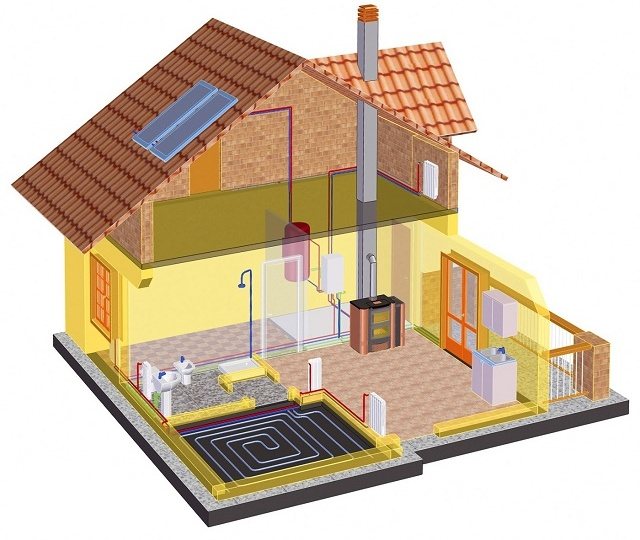

Option for placing the system in a country house
The fireplace circuit can be included in the heating system, as an addition to the main one, and as the main one. According to the device, the system is divided into two types: open (with natural circulation) and closed (with forced).
- In an open heating system, the fluid flow is ensured by the initial potential energy that it receives during convection. The heated water rises up the riser and flows along the entire line, made at a slope. This system uses only metal pipes. Its installation is carried out by experienced workers, since any mistake will lead to stagnation of the liquid in one specific place.
In order for the water to expand when heated, a branch is constructed at the very top of the system in the form of an expansion tank. Such a heating system could be called less expensive, but today the cost of metal pipes is so high that it makes this statement false.
- The closed system is assembled from plastic pipes and requires the installation of a pump for forced circulation of water. The idea behind such a system is that as the fluid expands, pressure increases. This leads to an increase in the boiling point. Such water can be heated by more than 100 ° C degrees.
Good to know: How to clean a fireplace, what tools and means should be used
Of course, in practice, such indicators are not allowed, however, it has been noticed that the system under pressure is more effective. The expansion tank is also present, only it is closed, and there is a rubber baffle inside it. It zones the tank into two parts: the first compartment is for water, and the other part contains pressurized air.
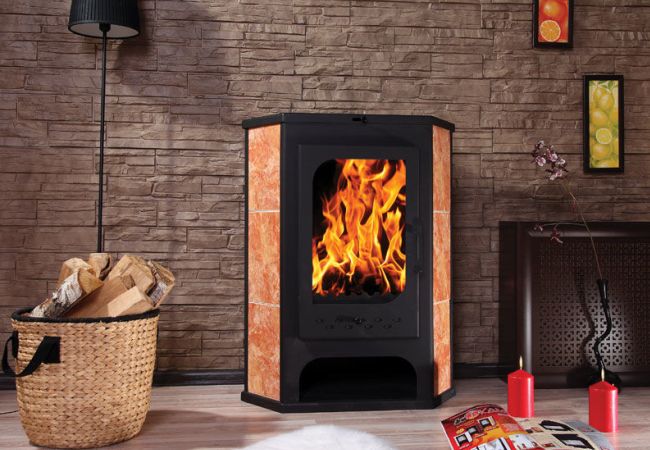

A small but very useful device in the household
In order not to be distracted from the question of the fireplace, it should be noted that fireplaces with a heat exchanger can be included in an open and closed system.
Fireplaces with water heating
Heating of premises is probably the main characteristic that gives a sense of convenience to the residents. Various heating systems are designed to heat the home in the most comfortable and harmless way, while maintaining the comfort and beauty of the interior. One of the popular options is a water fireplace.
Wood-fired water fireplaces can be used as the main or backup heating equipment. In the case when the fireplace is considered the main heater, a special heating system is being developed, which can, in addition to heating buildings with an area of 400 square meters, supply it with hot water for traditional needs or a floor heating system. A water fireplace can also act as an additional source of heat in an already installed heating system. In this case, if the fireplace is melted, the automatics will turn off the remaining heat sources, which is achieved by monitoring the temperature of the coolant in the system with special sensors.In the warm season, when the need for heating disappears, the water fireplace can be used exclusively for obtaining hot water. A water fireplace can significantly increase the efficiency of using the heat generated during fuel combustion. At the same time, the water fireplace remains a fireplace and allows you to enjoy the view of an open flame. A significant advantage of such devices is that it does not require the combustion of special fuel, but allows the use of traditional firewood.


There is a metal firebox in the fireplace device, in which fuel is burned. Flue gases wash around heat exchange tubes, inside of which water circulates. This water is heated by hot gases, which in turn are cooled. To ensure the normal circulation of the coolant in the heating system, the necessary piping elements are connected to the heat exchange tubes of the fireplace to supply hot water to the heating system. The appearance of the fireplace is complemented by a special portal, the external decoration of which is selected so that the fireplace becomes a worthy element of the interior of the room in which it will be installed. The power control of the fireplace is carried out by adjusting the air flow through the fireplace blower.
Cassette fireplace with air ducts
During operation, a system of natural and forced air convection can be used. With the use of air ducts - special pipes, ducts and fans, rooms located at a considerable distance from the heater can be heated. Some types of heaters of this type can easily turn into conventional ones with an open flame when the door is open.
What is a cassette fireplace
Its principle of operation is that hot air heated by an insulated firebox from the outside enters the room through the air ducts, heating it. Cast iron should be recognized as the best material for manufacturing. This material keeps heat for a long time and gives it to the surrounding space.
Don't Miss: Electric Fireplace with Live Flame Effect: Features, Advantages and Disadvantages.
Important! Steel housings and casings have a significant drawback. If used improperly, they can get defects, which are called burnout. The wall becomes thinner, becomes brittle, and in the future an unforeseen hole is formed, threatening fire safety and leading to the possibility of combustion products harmful to human breathing entering the room.
A separate group is made up of angular modifications. This type of heater, while retaining all the useful properties and qualities, allows you to place it so that it takes up less space in comparison with standard types.
The dimensions of the devices depend on the purpose and configuration. So, for built-in fireboxes, they are determined by height, width and depth. For those who are distant, the concept of dimensions is introduced, that is, the place, volume and area that they will occupy in the room after installation. This information will be required for the design of the placement and the subsequent summing up of stationary engineering networks and communications:
- water supply;
- forced convection and ventilation - pipes and ducts;
- electric power supply;
- additional decorative lighting;
- security systems.
It is good if the room in which the installation is planned will be equipped with an automatic warning and fire extinguishing system.
During construction work in rooms with heating systems, a minimum amount of finishes with increased flammability should be used.
Advice! Interior furnishings - armchairs, sofas, tables, carpets, tapestries, fabric curtains and drapes should be kept at a safe distance from the source of the flame.
Freestanding fireplace heaters can have their own cladding and decorations in the form of cast metal plates and ceramic or stone tiles with patterns or tiles.Sometimes their appearance is stylized for different eras, and exotic names are assigned to the models, for example, Vesuvius, Brandenburg and others similar. So that it makes it very easy to fit the heaters into the interiors of any premises with a variety of finishes.
Don't Miss: Pellet Fireplace: Features, Pros and Cons
Products are produced both by their own manufacturers and foreign ones. The domestic version, practically not inferior to the imported ones, either in safety, or in the use of optimal materials, or in the quality of manufacture, usually differs in a not too high price and a worthy choice.
Among the foreign manufacturers on the Russian market, the Scandinavian countries stand out, especially cast iron heaters, Finland. They are characterized by increased efficiency (efficiency) and are available for both built-in and free-standing versions.
Another popular manufacturer is the French company Supra, famous for its exquisite finishes and cladding.
Cassette stove fireplace


Photo: Cassette stove fireplace
If the heater is installed in a small room with year-round use (for example, a summer cottage or garden house), it can be combined with an oven that has hobs and an oven for cooking.
A device used as a decorative element of the interior is best heated using wood-based materials for the house in the form of chopped logs or large scraps of boards.
When the device is needed only for heating, any combustible materials can be used - coal, old paper and waste paper, pressed briquettes from sawdust and other waste from woodworking enterprises.
Water fireplace and its benefits
1. A water fireplace is a more affordable device than traditional heating boilers;
2. Installation of a water fireplace will not require alteration of the existing heating system;
3. The fuels used in the fireplace are cheap and readily available;
4. The power of the fireplace will be enough to heat a large area, but at the same time it will have an attractive appearance;
5. A cast iron water fireplace can be installed in rooms where only the most elementary fire safety rules will be observed;
6. Convective circulation of hot water in the heating system eliminates the consumption of electricity or other types of energy by the fireplace;
7. The water fireplace is a stand-alone device with the simplest operating algorithm.
Do not forget about the auxiliary elements that a water fireplace can be equipped with, which will significantly expand its capabilities. So one of the main auxiliary elements in the delivery of the boiler is the grill, thanks to which the fireplace not only becomes an element of the heating system, but also an item on which you can cook delicious food. And for those who like to admire the flames, but at the same time are very worried about safety, the fireplace can be equipped with special transparent screens that allow you to admire the fire and at the same time greatly reduce the likelihood of fires.
Oven location
If the stove is in a rest room, then when it burns in the cold season, heat will be transferred in the room naturally. If the heat from the stove is not enough, then a radiator is installed in the room. The system is equipped with a distribution manifold from which 2 pipes emerge. One leads to the steam room, the other to the relaxation room.
Heat begins to be supplied immediately when the oven heats up. On the 2nd pipe, a tap is provided that can turn off the steam heating. This is necessary so that in the summer it is comfortable to relax in the room. For the summer, they will equip a veranda near the bathhouse. An intense heat is emitted from the oven. After the steam room, you can go out into the fresh air.
If the bath is used in the summer, but the steam line does not have an additional branch, then it is recommended to slightly alter the oven. If it is brick, then 3 tiers are provided in the firebox. The distance between the tiers is up to 40 cm.In winter, firewood is placed on the lower grate. The heat from the stove will go to the dressing room.
In the fall, firewood is placed on the second tier. In the summertime, firewood is placed on the upper tier. In this case, all the heat will enter the heat exchanger and further into the main line. Heat will not enter the lounge. Doors to the firebox are made double. This additionally isolates the dressing room from the firebox.
If the oven is in the house. It was built to heat living quarters, then a separate circuit is displayed for the bath. A crane must be installed on it. When it is opened, steam will enter the bath and heat the steam room and the rest of the rooms.
If the tap is closed, then the heating in the bath is turned off. It is necessary to provide for a separate disconnection of the circuit that runs through the living rooms of the house. In this case, the sauna can be heated in the summer as well. Otherwise, the steam will go along the highway, which is located in the house.
We recommend: Features of a steam heating device in a private house
In order not to make an additional circuit for obtaining hot water, a separate circuit is brought out in the condensate storage tank. There will be enough water for the needs of vacationers. You should always make sure that there is water in the container. The minimum level is 10 cm. In this case, the system will not stop working, the coolant will circulate normally.


When installing the stove, consider the material and source of heating. A wood-fired brick oven takes a long time to burn, but it also cools down for a long time. A unit with a metal body heats up in a short time, but also cools down quickly.
Fuel varies. The sauna will have a pleasant smell if you use firewood as fuel. They purchase gas-fired furnaces. Gas and wood will make the heating in the bath autonomous. If the oven is powered by electricity, then it is convenient to use.
With the help of program control, the heating mode is set: you can not interrupt the rest in the bath, but the heating in this case will not depend on the electricity supply. Network outages can ruin spa treatments.
YouTube responded with an error: Access Not Configured. YouTube Data API has not been used in project 268921522881 before or it is disabled. Enable it by visiting https://console.developers.google.com/apis/api/youtube.googleapis.com/overview?project=268921522881 then retry. If you enabled this API recently, wait a few minutes for the action to propagate to our systems and retry.
- Similar posts
- Features of a steam heating device in a private house
- How is a steam-heated stove arranged?
- What are the types of pipes for steam heating?
- What are the features of steam heating "Leningradka"?
- Which wood stoves are suitable for steam heating?
- How does a low pressure steam heating system work?
Cons of fireplaces with a water circuit
But with all the advantages of water fireplaces, these devices are not without some disadvantages. In particular, the efficiency in them is not high enough to provide a decent level of heating for premises in the far north. However, using a water fireplace in conjunction with other heating methods can reduce fuel consumption by 40%. The flue gas recovery system is designed to increase the efficiency of the fireplace, which can be equipped with fireplaces at the request of the customer. In this case, due to the heat of the exhaust flue gases, the combustion air is heated.
An additional disadvantage of a water fireplace is completely manual control. This aspect severely limits the use of water fireplaces as the main sources of heat, but allows them to be widely disclosed as backup sources of heating.
Traditionally, the choice of a fireplace should be carried out taking into account the required power, which will be supplied for heating. It is believed that for heating 10 square meters of a room, the height of which is 2.5 m, 1 kW of energy must be spent. Knowing this and the area of the room, it is easy to set the required power of the fireplace.Moreover, this value should coincide with the rated power of the heating device. In addition to the nominal power, the passport of the fireplace also indicates the maximum and minimum power that the fireplace is capable of delivering for a short time in case of a strong cold snap or thaw, but in order for the resource of the fireplace to be as large as possible, these operating modes should be avoided.
